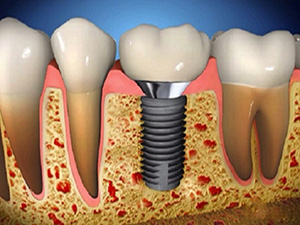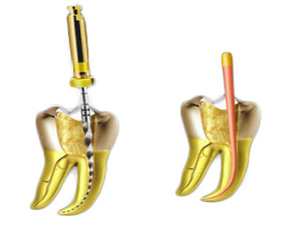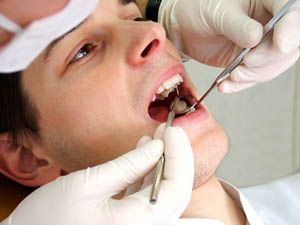Tooth Bleaching
Tooth bleaching is a kind of treatment which is applied, in a dentistry clinic, on the teeth whose color is dark or
darkened due to afterward factors.Your teeth can become more white and aesthetic with this method, regardless of whatever
the reason is.Office bleaching is applied by a dentist in a dentistry clinic for approximately 60 minutes in a single operation.
Dental Implant
What is a Dental Implant?
Implants are artificial titanium tooth roots which will be placed to the jawbone instead of the teeth lost by
various reasons. The implants are supplying better speaking and chewing functions in comparison with the traditional
casings and prosthesis, and they also bring a natural look to your face. An implant is a comfortable and reliable
application. The operation can be executed under local anaesthesia without feeling any pain or discomfort.
In necessary cases general anaesthesia may also be applied.
Advantages of Implants
The prosthesis, done after implant treatment are the most similar to your own natural teeth. Implant can provide a better
speaking and chewing ability than traditional crowns/dentures. It is also a more natural and aesthetic application.
Thanks to the implant treatment the missing teeth are being retrieved without having to make any operation on the neighbouring teeth.
Implants help increase retention of total prostheses.The much weak retention of mandible total prostheses would be increased considerably
by placing of two implants into the lower jawbone even the patient does not possess sufficient bone quality
After Implant Treatment
Implant treatments is one of the most popular treatments of the last years. After this treatment it is nowadays possible
to continue with your social life after treatment. The second step of implant treatment is the crown on the implant.
For this treatment patients have to wait 2-4 months for the integration of the implants with the jawbone.
It’s Worth It
Although the implant treatments might seem and be regarded as expensive and costly applications at first sight,
their cost figures may easily and reasonably be justified when the comfort, naturalness and aesthetics they offer
to the patients are taken into consideration. And don’t forget, this is a durable solution, not to compare denture or
bridge treatments. When you thing about its comfort, aesthetic, compared with dentures, once again you will understand
that it is the best and satisfying solution.
A Lifetime With My Implant
The dental implants have not been observed of being problem-free throughout lifetime. The length of their average life
span depends on various factors. Oral and dental hygiene of the patient is the primary factor that affects a dental
implants average life. With a correct mouth care your implant will provide you a beautiful smile, pleasurable talking
and tasteful eating.
Endodontics
The endodontics concerns with the diseases of tooth’s pulp. The pulp is located in the center of the tooth and in the root canals within each tooth root.
The pulp, which consists of connective tissue, nerves and blood vessels, nourishes the tooth when the tooth erupts. The pulp can be removed safely from the pulp
chamber and root canals, after the tooth becomes mature. The endodontic treatment is the removing of the pulp that is also known as the root canal treatment or root
Canal therapy.
Root Canal Treatment
If there is an infection or an irreversible damage to the pulp the root canal treatment is needed. An untreated cavity is a may cause the pulp infection. The enamel
and the dentin of the tooth are eroded by the decay until it opens into the root canal system. And the bacteria infect the pulp. The antibiotic treatments are not
effective for the infections inside teeth. The infection causes the inflammation and this inflammation restricts the tooth’s blood supply. So it is difficult for the
antibiotics in the bloodstream to reach the infection. Also the reduced blood supplies; make it difficult for the pulp to heal itself.
Tooth Crystal
What is tooth crystal?
It is a kind of crystal that is attached to tooth surface in order to add glamour to your smile.
How is tooth crystal attached?
It is attached to the surface of tooth that you request with special adhesives by your dentist without abrasion.
How is tooth diamond attached?
Tooth diamond is a natural stone and its surface that is attached is pointed. In order to adapt this pointed surface to the tooth, tooth surface is abraded in the
amount of it. Special adhesive is applied between the tooth and diamond.
Does tooth diamond fall off?
Because it is attached to tooth surface after abrasion, it is resistant to biting motions.
Can tooth crystal/tooth diamond be removed if I want?
Tooth crystal can be removed in any time you want. Your tooth regains its original look after it is polished.
Prosthesis
If decay in the mouth has caused excessive destruction in the teeth and the teeth have become so bad that they cannot be
filled, porcelain veneers is one of the main applications done in order to save the healthy main tooth.
The purpose of denture applications is to make artificial teeth which is compatible with the person’s face, that can
fulfil the function of chewing and speech as close as to natural teeth. Porcelain veneers can be applied to anyone over the age of 18 who has lost tooth or teeth for
some reason,who has broken, discoloured or deformed teeth and who does not prefer orthodontic treatment.
TYPES OF DENTURES
The loss of teeth may be recovered by different types of dentures depending on the number of loss:
Fixed dentures (Crowns and bridge like cemented dentures)
Removable dentures (total and partial dentures)
Implant Supported Dentures (fixed or removable)
FIXED DENTURES
Cemented dentures such as crowns and bridges the patient cannot remove.
CROWNS
It is the reduction and coating process of a tooth in cases where a tooth with excessive material loss due to decay,
breaking or any other reason cannot be completed with the filling.
BRIDGES
This is the process of reducing adjacent teeth and filling gaps by getting support from the special coatings on them,
in case of one or more than one missing teeth.
REMOVABLE DENTURES
Removable dentures are frequently used to complete missing teeth. It is used when the number of missing teeth cannot be
made up by a fixed denture. If you have lost some or all of your teeth, dentures will correct your appearance, your
speaking, your biting and chewing food. It is called a total denture in case all of the teeth in the jaw are missing,
and a partial denture if it completes some of the missing teeth in the jaw. Denture attachment of conventional partial
dentures is ensured by the clasps and hooks on the teeth. With Precision Attachment Partial Dentures more aesthetic
results are obtained with different fittings placed in the denture instead of hooks visible from outside.
IMPLANT SUPPORTED DENTURES
FIXED DENTURES:
Bridges and crowns made having support of the implant.
REMOVABLE DENTURES:
It is the total like denture preferred for mouths where bone support is not adequate and made with the support implants
Crown Coating
They are coatings are made in order to protect the integrity of the tooth in teeth with excessive loss of material, such as large decays and fractures.
What is Crown (Coating)?
They are coatings are made in order to protect the integrity of the tooth in teeth with excessive loss of material, such as large decays and fractures. It is one of the remedies used for discoloration of the teeth, for sealing the gap between the teeth, aligning the teeth outside the tooth clavicle, or for patients not satisfied with the appearance of their teeth. The Crown coating is made by placing a small amount on the reduced teeth.
What are the types of coating?
Metal aided porcelain crowns,
Zirconium-supported porcelain crowns,
Full ceramic crowns
Metal-supported porcelain coatings
The interior of the metal-supported porcelain coatings is metal. The metal gets into tooth form and covered with porcelain. Although they are high quality products in terms of aesthetics, they are able to have a problem of naturalness in terms of their light transmittance.
Zirconium-supported coatings
Zirconium-supported coatings are aesthetic coating applications with the closest light transmission to the natural tooth. The zirconium coating is an aesthetic solution that removes the allergy risk, creates a healthier fit with gingiva, and also has a much higher light transmittance than metal ceramic coatings. The white of the zirconium color does not present a problem in the light transmittance of the zirconium-supported porcelain coatings, such as metal-supported coatings.
Full ceramic coatings
Full ceramic coatings are the most successful coatings used for aesthetic purposes, especially in the front teeth, and are virtually impossible to separate from natural teeth. The light transmittance is rather high, because it does not contain an opaque substrate such as metal or zirconium. As the thickness of such coatings is less, the amount of material removed from the tooth surface is also reduced.


